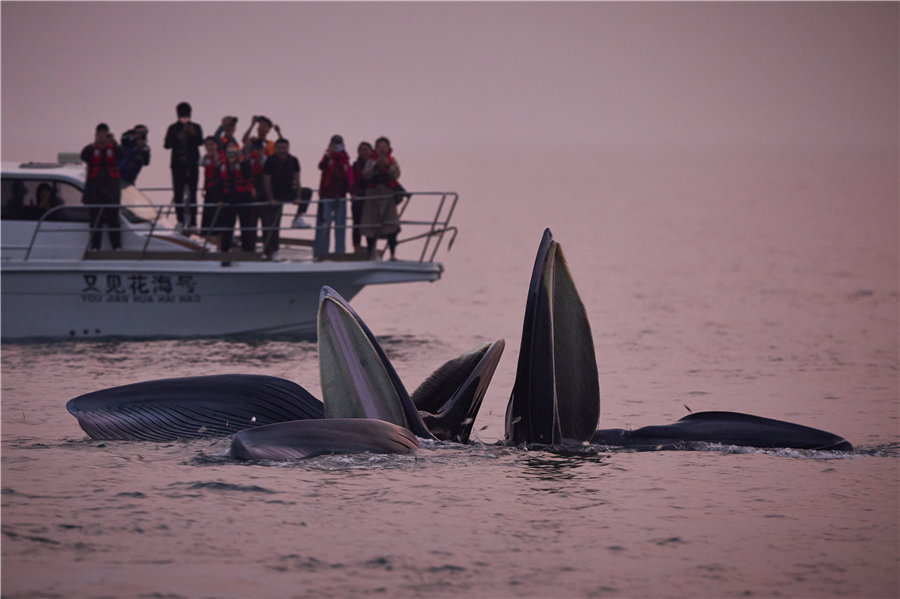Photos Capture Magnificence of Whales

A six-month old Bryde's whale follows closely beside its mother. [Photo by Huang Songhe/cpanet.org.cn]
Creatures in nature are interdependent, and each species plays an indispensable role in natural ecosystems.
The Bryde's whale, mainly found in tropical and subtropical waters, is considered a mysterious cetacean species. Measuring between 10 to 13 meters in length and weighing 10 to 15 tons, these whales have a significant impact on the marine ecosystem. By consuming large quantities of plankton and small fish, they not only sustain their own lives, but also serve as a food source for other marine organisms. Additionally, their feces provide essential nutrients for marine phytoplankton, helping to maintain an ecological balance.
According to monitoring data, the population of Bryde's whales in the waters surrounding Weihzou Island in Beihai, Guangxi Zhuang autonomous region, increased to 60 in 2023. This is indicative of a healthy ecological environment in the area.

The length of an adult whale can surpass that of a yacht. [Photo by Huang Songhe/cpanet.org.cn]
Each year, Bryde's whales migrate to the nearshore waters of Weizhou Island to give birth to their calves. This location is an ideal breeding ground due to its deep waters, absence of natural predators and abundant food sources.
As the only whale-watching spot along the shores of Chinese mainland, it has become a popular attraction for tourists. However, the increasing tourism has also brought some environmental challenges. Issues such as marine litter, overfishing and water contamination have emerged.

A Bryde's whale can take in hundreds of pounds of food in one bite. [Photo by Huang Songhe/cpanet.org.cn]
The local tourism authorities have set up designated areas for observing whales and are educating tourists to keep a safe distance to avoid disrupting the whales' lives and habitats. In addition, the local research team is actively conducting studies to gather scientific evidence and support the protection of the Bryde's whale.
Let's follow photographer Huang Songhe's lens to gain a deeper understanding of these magnificent creatures.

A Bryde's whale can take in hundreds of pounds of food in one bite. [Photo by Huang Songhe/cpanet.org.cn]

When Bryde's whale feed, black-headed gulls usually come to grab a share of their prey. [Photo by Huang Songhe/cpanet.org.cn]

The excrement of Bryde's whales can nourish various kinds of marine life. [Photo by Huang Songhe/cpanet.org.cn]

A rainbow appears from the blow as a whale resurfaces. [Photo by Huang Songhe/cpanet.org.cn]

At sunset, a group of tourists get the chance to watch three Bryde's whales feeding. [Photo by Huang Songhe/cpanet.org.cn]

A Bryde's whale feeds at the nearshore of Weizhou Island. [Photo by Huang Songhe/cpanet.org.cn]

A part of upper jaw bone from Bryde's whale, which is around two meters long, was found at Weizhou Island. [Photo by Huang Songhe/cpanet.org.cn]